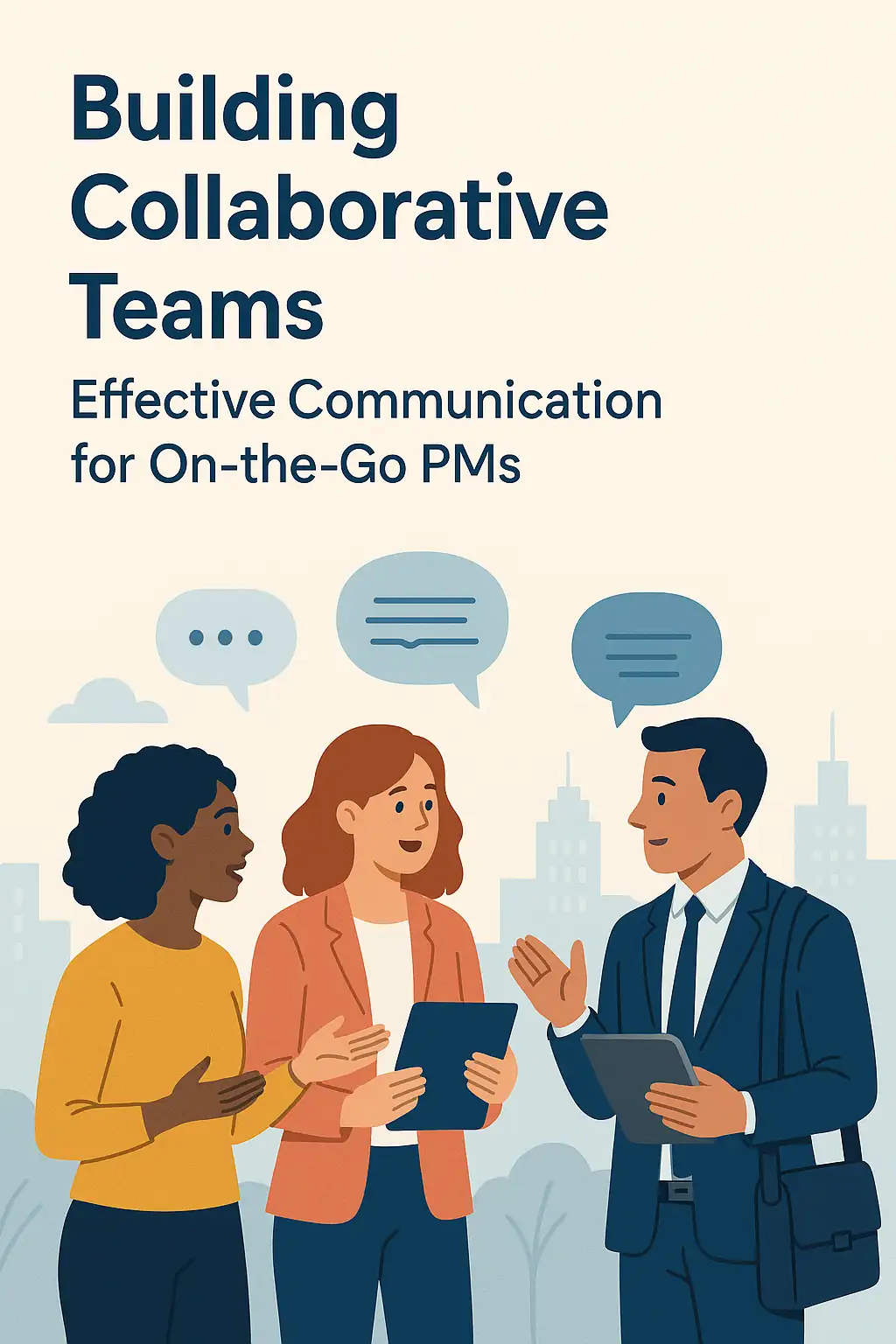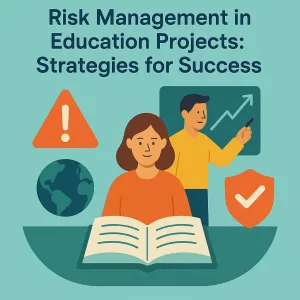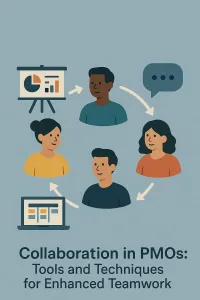Introduction
The concept of “on-the-go project management” (on-the-go PM) has emerged as a vital approach for project managers and team facilitators. On-the-go PM refers to the ability to manage projects flexibly and efficiently, often while working remotely or in a hybrid setting. This approach emphasizes adaptability, quick decision-making, and the use of technology to keep teams connected and projects on track, regardless of physical location.
The rise of remote teams has transformed the landscape of project management. With more organizations embracing flexible work arrangements, project managers are faced with unique challenges that require innovative solutions. Effective communication has become the cornerstone of successful remote collaboration, as it directly impacts team cohesion, task coordination, and overall project success. According to recent reports, a significant percentage of remote project managers cite communication gaps as one of the primary obstacles they encounter, underscoring the critical need for robust communication strategies in this context.
As we delve into the strategies that foster collaboration among remote teams, it is essential to recognize that effective communication is not merely a tool but a fundamental element that drives project success. By implementing structured communication protocols and leveraging technology, project managers can create an environment where team members feel connected, engaged, and empowered to contribute to their projects. This section will explore various communication strategies that can enhance collaboration and support the dynamic nature of on-the-go project management, ultimately leading to more agile and successful teams.
Understanding the Challenges of Remote Communication
Particularly for those managing teams on the go, effective communication is paramount. However, remote teams often face several barriers that can hinder collaboration. Here are some key challenges that project managers and team facilitators should be aware of:
- Time Zone Differences: One of the most significant challenges for remote teams is coordinating across various time zones. Team members located in different geographical areas may struggle to find suitable times for meetings, leading to delays in decision-making and project progress. This can create feelings of disconnection among team members, as they may not be able to engage in real-time discussions or brainstorming sessions, ultimately affecting team cohesion and morale [5][6].
- Lack of Non-Verbal Cues: Virtual communication often lacks the non-verbal cues that are present in face-to-face interactions, such as body language, facial expressions, and tone of voice. This absence can lead to misunderstandings, as team members may misinterpret messages or fail to grasp the emotional context behind them. The reliance on text-based communication can exacerbate this issue, making it crucial for project managers to encourage clarity and provide context in their messages [1][8].
- Potential Misunderstandings and Information Overload: In a remote setting, the risk of miscommunication increases, particularly when team members are not aligned on expectations or project goals. Misunderstandings can arise from cultural differences or varying communication styles, which can further complicate interactions. Additionally, the sheer volume of information shared in digital formats can lead to information overload, where team members may struggle to prioritize tasks or retain critical details. This can result in decreased productivity and increased frustration among team members [4][10].
By recognizing these challenges, project managers can implement strategies to enhance communication and foster collaboration within their remote teams. Addressing time zone differences through flexible scheduling, utilizing video conferencing to capture non-verbal cues, and streamlining information sharing can significantly improve the effectiveness of remote communication.
Establishing Clear Communication Channels
For those who are constantly on the go, establishing clear communication channels is essential for fostering collaboration within remote teams. The right tools not only facilitate effective communication but also enhance team cohesion and productivity. Here are some key points to consider when selecting and utilizing communication tools:
Popular Communication Tools and Their Features
- Slack
- Features: Channels for organized discussions, direct messaging, file sharing, and integration with various apps (e.g., Google Drive, Trello).
- Use Case: Ideal for real-time communication and quick updates among team members.
- Microsoft Teams
- Features: Video conferencing, chat, file collaboration through SharePoint, and integration with Microsoft Office applications.
- Use Case: Best suited for teams already using Microsoft products, providing a seamless experience for document collaboration and meetings.
- Zoom
- Features: High-quality video conferencing, screen sharing, breakout rooms for smaller group discussions, and webinar capabilities.
- Use Case: Excellent for virtual meetings, especially when face-to-face interaction is necessary for discussions or presentations.
- Asana
- Features: Task management, project tracking, team collaboration features, and integration with communication tools like Slack.
- Use Case: Useful for project management and ensuring everyone is aligned on tasks and deadlines.
- Trello
- Features: Visual project management boards, task assignments, and integration with other tools for enhanced functionality.
- Use Case: Great for teams that prefer a visual approach to tracking project progress and responsibilities.
Defining Tools for Specific Types of Communication
It is crucial to define which tools to use for specific types of communication to streamline interactions and avoid confusion. For instance:
- Real-time discussions can be effectively handled through instant messaging platforms like Slack or Microsoft Teams.
- Formal meetings should be scheduled via video conferencing tools like Zoom, ensuring that all participants can engage in meaningful dialogue.
- Project updates and task assignments can be managed through project management tools like Asana or Trello, where team members can track progress and responsibilities.
By clearly delineating the purpose of each tool, teams can minimize misunderstandings and ensure that everyone is on the same page.
Establishing Norms for Channel Use
To further enhance communication efficiency, it is beneficial to establish norms for channel use. This includes:
- Setting guidelines on when to use specific tools (e.g., using email for formal communications and Slack for quick questions).
- Encouraging team members to keep discussions relevant to the designated channels to avoid information overload.
- Regularly reviewing the effectiveness of the chosen tools and making adjustments as necessary to meet the evolving needs of the team.
By fostering a culture of clear communication and establishing well-defined norms, project managers and team facilitators can create a collaborative environment that supports the dynamic nature of on-the-go project management. This approach not only enhances productivity but also strengthens team relationships, ultimately leading to successful project outcomes.
Creating a Culture of Openness and Trust
Particularly for those managing remote teams, fostering a culture of openness and trust is essential for effective communication and collaboration. Here are some strategies and insights to help project managers and team facilitators cultivate this vital environment.
Strategies for Cultivating Transparency and Openness
- Establish Clear Communication Guidelines: Defining and implementing communication protocols can help set expectations for how team members interact. This includes specifying preferred communication tools, response times, and the types of information that should be shared openly. By creating a structured approach, team members are more likely to feel comfortable sharing their thoughts and ideas without hesitation [7].
- Encourage Active Listening: Practicing active listening is crucial in remote settings where non-verbal cues may be absent. Encourage team members to listen attentively, ask clarifying questions, and acknowledge each other’s contributions. This practice not only fosters respect but also enhances understanding among team members, leading to more meaningful conversations [6][14].
- Promote Bottom-Up Communication: Create an environment where team members feel empowered to share their insights and feedback. This can be achieved by encouraging suggestions and ideas from all levels of the team, which helps to build a sense of ownership and accountability [9].
Importance of Regular Check-Ins and Feedback Loops
Regular check-ins and feedback loops are vital for maintaining open lines of communication. These practices help ensure that everyone is aligned on project goals and can address any concerns promptly.
- Scheduled Team Meetings: Implementing weekly or bi-weekly team meetings can provide a platform for team members to discuss progress, share challenges, and celebrate successes. This consistent interaction helps to reinforce team cohesion and keeps everyone informed [5].
- One-on-One Check-Ins: In addition to group meetings, individual check-ins can be beneficial. These sessions allow team members to discuss personal challenges or feedback in a more private setting, fostering a sense of trust and support [4].
- Feedback Mechanisms: Establishing formal feedback mechanisms, such as surveys or suggestion boxes, can encourage team members to voice their opinions and experiences. This not only helps in identifying areas for improvement but also demonstrates that their input is valued [13].
Team-Building Activities that Foster Trust and Camaraderie
Engaging in team-building activities can significantly enhance trust and camaraderie among remote team members. Here are a few examples:
- Virtual Team-Building Games: Organizing online games or challenges can break the ice and encourage team members to interact in a fun and relaxed environment. Activities like trivia quizzes or virtual escape rooms can promote collaboration and strengthen relationships [12].
- Shared Learning Experiences: Hosting workshops or training sessions where team members can learn new skills together fosters a sense of community. This shared experience can help build trust as team members support each other in their learning journeys [15].
- Recognition and Appreciation Initiatives: Implementing a system for recognizing and celebrating individual and team achievements can enhance morale and trust. Acknowledging contributions publicly reinforces a culture of appreciation and encourages team members to support one another [8].
By focusing on these strategies, project managers can create a culture of openness and trust that not only enhances communication but also drives collaboration and productivity within remote teams. This foundation is essential for navigating the complexities of project management in a remote environment, ultimately leading to greater team success.
Leveraging Asynchronous Communication
Particularly for on-the-go project managers (PMs), asynchronous communication has emerged as a vital strategy for fostering collaboration within remote teams. This method allows team members to engage and contribute at their own pace, accommodating different schedules and time zones, which is essential in today’s dynamic work environment.
Defining Asynchronous Communication
Asynchronous communication refers to interactions that do not require all participants to be present at the same time. This can include emails, recorded video messages, project management software updates, and collaborative documents. The benefits of this approach for remote teams are significant:
- Flexibility: Team members can respond when it suits them, which can lead to more thoughtful and comprehensive contributions.
- Reduced Interruptions: By minimizing the need for real-time meetings, team members can focus on their tasks without constant disruptions, enhancing productivity and deep work [12][14].
- Inclusivity: Asynchronous methods allow for participation from individuals in different time zones, ensuring that all voices are heard and valued [15].
Tips for Crafting Clear and Concise Messages
Effective communication is crucial in asynchronous settings. Here are some strategies to ensure your messages are clear and impactful:
- Be Direct and Specific: Clearly state the purpose of your message and what you need from the recipient. Avoid vague language that can lead to misunderstandings.
- Use Bullet Points: When conveying multiple points, bullet points can help organize information and make it easier for recipients to digest [6].
- Limit Length: Keep messages concise to respect the recipient’s time. Aim for clarity without overwhelming them with information [10].
- Encourage Questions: Invite team members to ask for clarification if needed, fostering an open dialogue even in an asynchronous format [7].
Importance of Maintaining Documentation and Shared Resources
In a remote work environment, maintaining thorough documentation and shared resources is essential for effective asynchronous communication. Here’s why:
- Centralized Information: A well-organized repository of documents, project updates, and resources ensures that all team members have access to the information they need, reducing the chances of miscommunication [9].
- Accountability: Documenting decisions and discussions helps track progress and holds team members accountable for their contributions [8].
- Knowledge Sharing: Shared resources promote a culture of collaboration, allowing team members to learn from each other and build on each other’s ideas [15].
By leveraging asynchronous communication effectively, project managers can enhance collaboration within their teams, ensuring that everyone remains aligned and engaged, regardless of their location or schedule. This approach not only fosters a more inclusive work environment but also drives project success through improved communication practices.
Encouraging Active Participation and Engagement
For those operating in a remote or hybrid environment, fostering active participation and engagement among team members is crucial for success. Here are several strategies that can help project managers and team facilitators ensure that all voices are heard and valued, thereby enhancing collaboration within their teams.
Techniques for Encouraging Input from Quieter Team Members
- Create a Safe Space for Sharing: Establish an environment where team members feel comfortable expressing their thoughts without fear of judgment. This can be achieved by setting ground rules for discussions that promote respect and openness. Encouraging a culture of psychological safety allows quieter members to share their ideas more freely.
- Use Direct Questions: During meetings, project managers can directly invite quieter team members to share their thoughts by asking specific questions. For example, “What do you think about this approach, [Name]?” This not only encourages participation but also shows that their input is valued.
- Implement Breakout Sessions: In larger meetings, consider using breakout rooms for smaller group discussions. This setting can be less intimidating for quieter individuals, allowing them to contribute more comfortably. Afterward, each group can share their insights with the larger team.
Exploring the Use of Polls and Surveys to Gather Feedback
- Utilize Real-Time Polling Tools: Incorporating tools like Slido or Mentimeter during meetings can facilitate instant feedback. By allowing team members to vote on ideas or express their opinions anonymously, project managers can gather insights from those who may hesitate to speak up in a larger group setting.
- Conduct Regular Surveys: Beyond meetings, regular surveys can be an effective way to gauge team sentiment and gather feedback on various aspects of the project. This can include questions about team dynamics, project progress, and individual workload. Anonymity can encourage more honest responses, leading to actionable insights.
- Follow Up on Feedback: After collecting feedback through polls or surveys, it’s essential to acknowledge and act on the input received. Sharing how the feedback will influence decisions or project direction reinforces the value of team contributions and encourages ongoing participation.
Highlighting the Importance of Recognizing and Valuing Contributions from All Team Members
- Celebrate Contributions Publicly: Recognizing individual contributions during team meetings or through company communication channels can boost morale and encourage further participation. A simple acknowledgment of a team member’s idea or effort can go a long way in making them feel valued.
- Encourage Peer Recognition: Implementing a peer recognition program can empower team members to appreciate each other’s contributions. This not only fosters a collaborative spirit but also encourages quieter members to engage more actively, knowing their efforts will be recognized by their peers.
- Provide Constructive Feedback: When team members share their ideas, providing constructive feedback is crucial. This not only helps them improve but also shows that their input is taken seriously. Encouraging a two-way dialogue can enhance engagement and foster a culture of continuous improvement.
By implementing these strategies, project managers and team facilitators can create a more inclusive environment that encourages active participation and engagement from all team members. This not only enhances communication but also strengthens collaboration, ultimately leading to more successful project outcomes.
Utilizing Technology to Enhance Communication
Especially for those who are constantly on the go, effective communication is paramount. Leveraging technology can significantly enhance collaboration among remote teams, ensuring that everyone stays aligned and engaged. Here are some key tools and technologies that can facilitate better communication for project managers and team facilitators.
Project Management Software with Integrated Communication Features
- Trello: This visual project management tool allows teams to organize tasks using boards, lists, and cards. Trello’s integration with communication features, such as comments and notifications, enables team members to discuss tasks directly within the platform, reducing the need for external communication channels.
- Asana: Asana offers a robust project management solution that includes task assignments, deadlines, and progress tracking. Its comment sections and project updates facilitate real-time communication, allowing team members to share feedback and updates seamlessly.
- Monday.com: This platform combines project management with communication tools, enabling teams to collaborate effectively. With features like status updates, file sharing, and integrated chat, Monday.com helps keep everyone informed and engaged, regardless of their location.
The Role of Video Conferencing Tools
Video conferencing tools have become essential for fostering face-to-face interactions in a remote work environment. They bridge the gap created by physical distance, allowing team members to connect visually and verbally.
- Zoom: Known for its reliability and ease of use, Zoom allows for virtual meetings, webinars, and breakout rooms. This flexibility enables project managers to conduct team meetings, one-on-ones, and brainstorming sessions effectively.
- Microsoft Teams: This platform not only supports video conferencing but also integrates with other Microsoft Office tools. Teams can collaborate in real-time during meetings, share screens, and access shared documents, enhancing the overall communication experience.
- Google Meet: As part of the Google Workspace, Google Meet allows for secure video calls and integrates seamlessly with Google Calendar and Google Docs. This integration makes it easy to schedule meetings and collaborate on documents during discussions.
Benefits of Collaborative Document Platforms
Collaborative document platforms are vital for ensuring that all team members can contribute to and access project-related documents in real-time.
- Google Docs: This widely-used platform allows multiple users to edit documents simultaneously, making it easy for teams to collaborate on project plans, reports, and presentations. The commenting feature enables team members to provide feedback directly within the document, streamlining communication.
- Notion: Notion combines note-taking, task management, and database functionalities in one platform. Teams can create shared workspaces where they can collaborate on documents, track project progress, and maintain a knowledge base, all while communicating effectively.
By utilizing these technologies, project managers can enhance communication within their teams, fostering a collaborative environment that is essential for successful project execution. Embracing these tools not only improves efficiency but also strengthens team cohesion, making it easier to navigate the challenges of remote work.
Measuring Communication Effectiveness
Particularly for those managing remote teams, effective communication is paramount. As project managers and team facilitators strive to build collaborative teams, it is essential to measure the effectiveness of communication strategies. Here are some key points to consider:
Metrics for Evaluating Communication Effectiveness:
- Response Times: Tracking how quickly team members respond to messages can provide insights into the efficiency of communication channels. Short response times often indicate a high level of engagement and clarity in communication [3][11].
- Engagement Levels: Monitoring participation in meetings, discussions, and collaborative platforms can help gauge how involved team members are. High engagement levels suggest that team members feel comfortable and valued in the communication process [4][12].
Importance of Regular Team Retrospectives:
- Conducting regular retrospectives allows teams to reflect on their communication practices. This process helps identify gaps and areas for improvement, fostering a culture of openness and continuous learning. By discussing what worked well and what didn’t, teams can adapt their strategies to enhance collaboration [6][10].
Encouraging Continuous Improvement:
- Feedback is a critical component of effective communication. Project managers should create an environment where team members feel safe to share their thoughts on communication practices. This feedback can lead to actionable insights that help refine communication strategies over time. Adapting to the needs of the team ensures that communication remains effective and relevant [10][14].
By implementing these strategies, project managers can not only measure the effectiveness of their communication but also foster a collaborative environment that enhances team performance. Continuous assessment and adaptation of communication practices are vital for the success of remote teams, ultimately leading to improved project outcomes.
Conclusion
Particularly for those navigating the complexities of remote work, effective communication stands as a fundamental pillar for building collaborative teams. As project managers, it is essential to recognize that clear and timely communication not only enhances team cohesion but also drives project success. By establishing robust communication protocols, you can ensure that all team members are aligned with project goals and feel connected, regardless of their physical location [1][10].
Adapting your communication style to meet the diverse needs of your team is crucial. Each team member may have different preferences for how they receive and share information, whether through video calls, messaging apps, or project management tools. By being flexible and responsive to these preferences, you can foster an environment where everyone feels empowered to contribute and collaborate effectively [4][12].
Find out more about Shaun Stoltz https://www.shaunstoltz.com/about/.
This post was written by an AI and reviewed/edited by a human.



